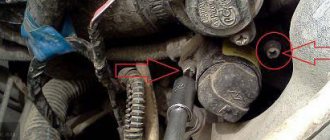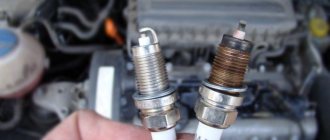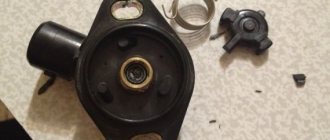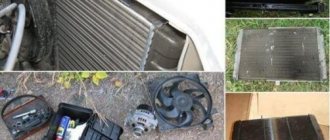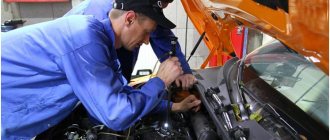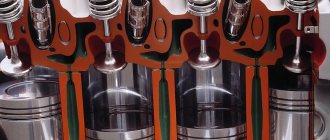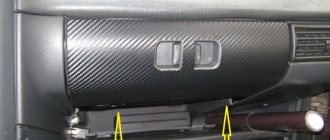Many motorists have experienced high engine speeds when idling. But not all car enthusiasts know why this happens, much less how to solve the problem without contacting a car service center. The article will help you analyze the issue in more detail, as well as find ways to solve the problem.
Ways to eliminate the “sore”
How to fix the problem? For this we only need a screwdriver. Let's begin the procedure.
- By disconnecting the terminal block and also unscrewing two screws, we dismantle the assembly.
- We notice that traces of rust inside interfere with the movement of the wheel that regulates the position of the damper.
- We fill the insides of the defective device with a penetrating anti-rust aerosol.
- Use a development screwdriver to turn the wheel.
- We reassemble in reverse order.
Check to see if the engine idle speed is now high. The problem should go away.
Now let's look at another case. Let's say we have high idle speed in a VAZ 2114. This is what we do when faced with this situation.
When clarifying the circumstances of the problem under investigation, we always initially check the operation of the idle speed sensor. This device consists of a needle built inside an electromagnetic coil. The needle either moves inside the coil, moving away from the hole in the throttle pipe, or moves out, closing this hole, thereby stopping the supply of air for combustion of the mixture.
Also read about adjusting engine idle speed and repairing a Tavria car muffler with your own hands. This element is located at the throttle valve, opposite the gas pedal cable. To diagnose it, we pull out the terminal block from it, start the car, after which we see that we still have high engine speeds that have not changed at idle. Then we remove this defective unit, then clean it or replace it. For work we take:
- Unscrew the two screws. We take out the broken node.
- We connect the wiring to it. Turn on the ignition. If the needle of the device moves slightly inside the coil to the touch, then it is working.
- If the needle does not react when an electric current is applied, wash the device with a toothbrush using gasoline.
- We do the assembly in reverse order.
When you cannot restore the functionality of this unit with your own hands, it is better to purchase a new one. Moreover, the cost of spare parts is low.
Other fixes
This node can be diagnosed as follows. It is necessary to disconnect the terminal block from our mass flow regulator, and then start the engine, after which it is necessary to drive the crankshaft speed above 2000 rpm.
In this case, the emergency mode is automatically launched, portions of the mixture are now calculated only by the position of the damper. If the sensations show that the car with the disconnected sensor has become more dynamic than with the connected one, then the malfunction of this unit is obvious. To replace it, take the following tools:
- Phillips screwdriver;
- flat screwdriver.
- After turning off the engine, disconnect the wires from the mass air flow sensor.
- Loosen the clamp and remove the hose on the inlet pipe.
- We dismantle the defective device by unscrewing two bolts.
- We are replacing the device.
- We do the assembly, moving backwards point by point.
This is how this cause of high revs is eliminated.
For some reason it didn't help
Now let's look at another situation. The car owner changed, for example, the idle speed sensor, and the crankshaft speed became high, or remained high as before.
The reasons for this unpleasant phenomenon may be as follows.
- Most likely, the car enthusiast made the replacement just like that, at random, maybe it would stop turning too quickly. The real state of affairs suggests that the fault needs to be looked for elsewhere.
- If this sensor is not a completely new model, it has an adjusting bolt, it may need to be tightened in order to adjust the problem unit. Modern idle air valves do not require any additional adjustment when installed. However, for example, if the Priora has high idle speeds, then you can look for the adjusting screw on this car.
- It is possible that the new spare part was defective.
- The new spare part was installed incorrectly.
VAZ 2114 engine modifications
Over the ten years of serial production of the VAZ 2114, the following was installed on it:
- 1.5i . Engine VAZ 2114 with a volume of 1.5 liters, with 8 valves. Its maximum power was 78 hp. C. at 5800 rpm. Torque at 3800 rpm reaches 116 N.m. Per 100 km in the mixed cycle, gasoline consumption is 7.3 liters. In this modification of the internal combustion engine, an injection intake with control through the electronics was used, instead of the outdated carburetor, and a new camshaft with corrected phases was installed. Thanks to the introduction of an injector into the VAZ 2114 engine, engineers were able to increase the efficiency of the engine, increasing its power, and at the same time reducing fuel consumption. This was a big starting step in the development of the entire range of internal combustion engines of the Volzhsky Automobile Plant.
- 1.6i . In 2004, a modification of the engine was released with an increased volume of 1.6 liters. It developed a power of 81 hp. With. at 5200 rpm and 125 N.m. at 3000 rpm. In the combined cycle, the engine consumes 7.6 liters of gasoline per 100 km. The VAZ 2114 engine with an injector and 8 valves received an increased volume due to the cylinder height increased by 2.3 mm, which made it possible to make a larger piston stroke. The ignition module was replaced by a coil. The internal combustion engine turned out to be more powerful and environmentally friendly, but fuel consumption increased compared to the previous model.
- 16V 1.6і (124) . Also in 2004, a 1.6-liter engine was released, but with 16 valves, that is, 4 for each cylinder. This engine already had 89 horsepower at the flywheel at 5000 rpm and 131 Nm of torque at 3700 rpm. The plant claims consumption in the combined cycle of 7.5 liters per 100 km. The VAZ 2114 8-valve engine with an injector received modifications in the form of an increase in the number of valves to 16 pieces. The rest of the characteristics remain the same. The car began to meet EURO-3 environmental requirements, gained an additional 8 horsepower and became a little more economical.
- 16V 1.6і (126) . In 2007, this engine was greatly modified, the volume remained the same 1.6 liters, but the power already reached 98 hp. With. at a speed of 5600 per minute, and the torque develops 145 N.m. at 4000 rpm. Fuel consumption was reduced to 7.2 liters per 100 km.
They worked hard on the old VAZ 2114 engine for 3 years and made several changes:
- the connecting rod and piston group is lightened by 39%;
- The timing drive has been changed, it has become automatically tensioned;
- valve holes have decreased in size;
- The quality of cylinder honing has improved significantly.
All these and some less significant modifications increased the torque of the engine and now it developed 98 hp. With. and had a peak torque of 145 N.m. At the same time, fuel consumption has significantly decreased. This internal combustion engine turned out to be the most successful of all and became a great advantage of the cars equipped with it.
Why might there be high idle speed?
One of the main reasons may be the failure of the IAC, the idle air regulator, which is responsible for adjusting the engine speed at idle. If the sensor is faulty. revolutions can “float”, rise and fall spontaneously. If the sensor completely fails, the car may simply stall at idle.
Also, increased speeds can be caused by a malfunction of the throttle position sensor (TPS). Over time, moisture gets under the sensor, which leads to the formation of oxide and rust on the regulator rod. To check this, you need to unscrew the sensor and carefully inspect it and the rod. If rust is found on them, they should be treated with penetrating lubricant or WD 40.
As a rule, the problem of increased speed on the VAZ 2110-12 lies precisely in these two sensors. Therefore, first of all, you need to pay attention to them.
Idle system
In a VAZ 2110 car, the idle speed (XX) consists of the following elements:
- fuel supply channel from the float chamber;
- XX jet for fuel;
- XX jet for air;
- bypass type channel;
- fuel outlet channel;
- controller (sensor) XX.
When the engine is operated in XX mode, two-thirds of the fuel passes through this system, the rest through the main dispenser. Fuel is supplied through the main channel of its entry, then passes through the XX fuel nozzle, after which a mixture of fuel and air is formed, and the air flow is directed through a special channel in the main nozzle body.
Next, the formed air-droplet solution flows through the carburetor lines to the screw for adjusting the flow of the XX fuel mixture. Then this solution is enriched with an air mixture from the bypass-type channel XX through the outlet line and, with added acceleration, passes into the intake-type manifold.
Where are the IAC and TPS sensors located?
So, first, let's check the IAC sensor. It is located on the throttle assembly below the TPS sensor. Dismantling it is very simple - remove the block from the sensor and use a Phillips screwdriver to unscrew the two bolts securing it. Then we pull out the sensor or perform diagnostics on it, read about this below.
The throttle position sensor is located above the IAC and is also secured with two bolts. It unscrews quite easily; there is no need to remove either the pipe on the throttle or the throttle itself. Disconnect the block, unscrew the two bolts and pull out the sensor.
To make sure that the problem with high speed is really in one of these sensors, and maybe in each other at once, you should diagnose them.
Cleanliness of the damper assembly
The throttle valve assembly is diagnosed by visual inspection for contamination. Clean the part with cotton swabs and a toothbrush moistened with a cleaning solution. For ease of work, the device is dismantled. After cleaning, it is recommended to blow out all channels and pipes of the unit with compressed air using a tire inflator.
To clean the part, it must be dismantled
Attention! It is recommended that the channel responsible for removing gases from the crankcase be completely filled with a cleaning solution before purging - the diameter of the element is very small and there is no other way to access it
Video: How to clean the throttle body
Is it possible to diagnose DPKV and DSA?
A breakdown of the DPKV and DSA (Hall sensor) is indicated by the Check Engine indicator that lights up on the car’s dashboard. Testing these devices is only possible using special instruments (oscilloscopes). You can first check the integrity of the wiring; if it is broken, the damage should be repaired.
- The DPKV sensor is installed on a bracket located in close proximity to the generator drive pulley.
- The DSA is located on the speedometer drive mechanism of the gearbox.
For a more detailed introduction to methods for detecting faults associated with engine malfunction in idle mode, it is recommended to watch the following video.
Diagnostics of the IAC sensor 2110
There are several ways to check the idle speed control. To check we need a multimeter. First, let's describe the simplest way:
IAC check method 1
- Disconnect the block from the sensor and unscrew the sensor
- Turn on the ignition
- We connect the block to the removed sensor, the needle in the sensor should move out, if not, then the sensor is faulty
IAC check method 2
- Disconnect the negative terminal of the battery
- Using a multimeter, we measure the resistance of the external and internal windings of the IAC, while the resistance parameters of contacts A and B, and C and D should be 40-80 Ohms.
- If the instrument scale is zero, it is necessary to replace the IAC with a serviceable one, and if the required parameters are obtained, we check the resistance values in pairs B and C, A and D.
- The multimeter should detect an open circuit
- With such indicators, the IAC is serviceable, and if they are absent, the regulator must be replaced.
IAC test method 3
- Disconnect the block from the sensor
- Using a voltmeter, we check the voltage - the “minus” goes to the engine, and the “plus” to the terminals of the same block of wires A and D.
- The ignition is turned on, and the received data is analyzed - the voltage should be within twelve volts, if less, then most likely there are problems with the battery charge; if there is no voltage, then you will have to check both the electronic control unit and the entire circuit.
- Then we continue the inspection with the ignition on, and analyze terminals A:B, C:D one by one - the optimal resistance will be about fifty-three ohms; During normal operation of the IAC, the resistance will be infinitely high.
Injector
Here everything is much more complicated: the operation of an injection engine is associated with many sensors, ECUs and other elements of the power unit, in particular the fuel system. But first things first.
Idle air control sensor (IAC)
If this device is faulty, the engine may stall at idle, or its speed will float, making jumps in the range of approximately 600-1200 rpm. Therefore, it is necessary to ensure that the device is working properly. This can be done using a multimeter. Procedure:
- First, measure the supply voltage on a pair of outer terminals A and D. To do this, place the black probe of the device to ground (any unpainted metal part of the car body), and the red one to the indicated terminals in turn. When the ignition is on, there should be 12 V. If this is not the case, check the voltage at the ECU terminals (for the VAZ 2110 these are pins 4 and 54). If there is 12 V here, look for an open circuit in the wiring.
- Set the tester to ohmmeter mode. Resistance between terminals A and B, C and D: should be 40-80 Ohms.
- Check the motor for short circuit. To do this, measure the resistance between A and D, B and C: the arrow of the device should tend to infinity.
TPDZ
That is, a throttle position sensor, which is responsible for the amount of fuel mixing with air. If the fuel supply is incorrect, the ECU will automatically give a command and the idle speed will increase. Therefore, it is necessary to check the TPS:
- Unclip the connector that fits the sensor: you will see 3 contacts: for the control signal, power and ground.
- Start the engine and measure the voltage at the power terminal: it should be approximately 5 V.
- Stop the engine and switch the tester to resistance measurement mode (throttle valve closed). Measure it between ground and signal contact: it should be 0.8-1.2 kOhm. When the damper is closed, the value is 2.3-2.7 kOhm.
How to remove and install a new sensor
To dismantle, simply unscrew a couple of mounting screws. Next, disconnect the end of the damper shaft and, rotating the new sensor, align the holes to screw in the screws. Put the connector on.
After completing the work, it is necessary to delete the error from the controller’s memory. To do this, remove the terminals from the battery for a period longer than 8 hours. If the error has not cleared, try driving in a gentle mode so that the ECU resets it itself. If you fail again, you will have to contact a car service (you will need a motor tester).
Throttle valve
Jamming of this mechanical device will result in an increase in the amount of air supplied to the cylinders. As a result, the ECU will work again and begin to increase the volume of fuel to balance the mixture. To solve the problem, remove the damper and clean it with chemicals. If there is no result, the part will have to be replaced.
Engine temperature sensor
As practice shows, this device breaks down quite often, because it is constantly exposed to temperature changes. It needs to be checked:
- Disconnect the block and with the ignition on (no need to start the engine), check the voltage at terminal “B” relative to ground: it should be 5 V. If the value is less than 4.7 V, you need to look for the reason: a break or short to ground is possible.
- Turn off the ignition and determine the resistance between contact “A” and ground: the correct value is 1 Ohm (no more and no less).
- Measure the resistance between ground and terminal “B”: it should be at least 1 Ohm.
- Check the functionality of the sensor. To do this, you need to measure the above resistances on a cold and warm engine. The values must be the same.
After the checks, it is recommended to reset the ECU errors, as indicated above in the section on TPS.
Mass air flow sensor (MAF)
During operation, this device gradually becomes covered with an oil film, which can lead to failure of the hot-wire anemometer, the element responsible for determining the amount of air. If the device does not cope with its task, the ECU receives incorrect information and the engine begins to increase speed.
Increased speed may also be due to a dirty air filter.
Intake manifold
It may have deformation or gasket breakdown. An increase in idle speed indicates an air leak.
To fix the problem you will have to remove the manifold. After dismantling, inspect it carefully: deformation can also affect engine warming up, its starting and other factors. Damage is eliminated by grinding, which is preferable to do in a car service center.
Electronic engine control unit
Incorrect operation of the ECU also affects high idle speeds. To restore the normal functioning of the “brains” you will need a special cable, computer and software.
It is highly not recommended to poke around here on your own: it is better to trust the specialists. In practice, after unprofessional intervention, the “do-it-yourselfers” still have to go to a specialized technical center to eliminate the consequences of their own “improvements.”
Generator
Although rare, it can also cause increased engine speed at idle. Why is this happening? If this unit does not produce enough current, the ECU will command the engine to spin up more strongly to bring the voltage up to normal. As a result, the turnover will increase.
Crankcase ventilation (PCV) system
It is needed to remove crankcase gases through a special valve in order to prevent pressure from increasing above normal.
If you can find the PCV valve, then carefully pinch the tube that fits it with pliers: when the engine is running, the speed should drop slightly. If this does not happen, the device must be replaced.
Turbocharger
Not all cars are equipped with such a “thing,” but it may be the “culprit” for high engine idle speeds, which can “automatically” decrease and increase. Air leaks may occur here due to a leak in the rotor shaft gasket. The same effect can be caused by wear of turbocharger parts (for example, bearings).
Diagnostics of TPS VAZ 2110
To diagnose the sensor we need a voltmeter.
- It is necessary to turn on the ignition and check the voltage between the slider contact and the minus with a voltmeter. The voltmeter should read no more than 0.7 V.
- Now you need to turn the plastic sector, thereby completely opening the damper, then measure the voltage again. The device must show at least 4 V.
- Turn off the ignition and disconnect the connector from the sensor. We check the resistance between the slider contact and some terminal.
- Slowly, turning the sector, monitor the voltmeter readings. Make sure that the needle moves smoothly and slowly; if you notice jumps, the throttle position sensor is faulty and must be replaced.
Symptoms of TPS malfunction
- Deterioration of vehicle dynamics
- Floating idle speed
- Jerking during acceleration
- Increased idle speed
- The engine may stall at idle
Which TPS sensor to choose for replacement
For stable and long-term operation of the sensor, we advise you not to buy too cheap analogues of questionable quality. The factory installed throttle position sensor was GM 2112-1148200 .
- DPDZ /2110/ GM 2112-1148200 price from 300 rub.
- DPDZ /2110/ PEKAR 2112-1148200 price from 200 rub.
- TPDZ /2110/ StartVOLT VS-TP 0110 price from 200 rub.
- TPDZ /2110/ HOFER HF 750260 price from 150 rub.
- DPDZ /2110/ CJSC Account Mash 2112-1148200-05 price from 400 rub.
- DPDZ /2110/ JSC RIKOR ELECTRONICS 2112-1148200 price from 300 rub.
Replacing the Throttle Position Sensor on a VAZ 2110
Using a Phillips screwdriver, unscrew the two sensor mounting bolts, disconnect the block and remove the sensor.
If traces of rust or oxidation are found on the rod, which regulates the speed, it is necessary to clean it with penetrating lubricant.
Next, a new sensor is installed, the block is connected and the idle speed is checked.
Which IAC sensor to choose for replacement?
2112.1148300-04 was installed on cars 2110-12 . If for some reason you cannot buy a factory one, you can install an analogue sensor from other manufacturers.
- РХХ /2110-12/ engineer. (2112.1148300-04) factory (KZTA, Kaluga) price from 600 rub.
- РХХ /2110-12/ engineer. FENOX SIP10100O7 price from 300 rub.
- РХХ /2110-12/ engineer. HOFER HF 750381 price from 250 rub.
- РХХ /2110-12/ engineer. MANOVER MR-2112-1148 price from 350 rub.
- РХХ /2110-12/ engineer. StartVOLT VSM 0112 price from 450 rub.
Replacing the IAC sensor VAZ 2110
Disconnect the block from the sensor
Using a Phillips screwdriver, unscrew the two mounting bolts and pull out the sensor
We install the new one in the reverse order.
Similar articles:
- Idle speed sensors. IAC VAZ 2114 Malfunctions and replacement
- Diagnostics and replacement of speed sensor VAZ 2114
- Replacing the oxygen sensor Lada Granta -...
Safety precautions
Previously, idle speed adjustment in carburetor cars was done manually, for which special carburetor adjustment screws were provided. This event was complex and required certain skills; additional instruments were also needed: a gas analyzer and a tachometer. However, such cars are becoming increasingly rare on the roads.
Today, the process of replacing the regulator does not present any great difficulties. However, it is necessary to follow the correct and most appropriate sequence of work. It is worth noting that all work can only be carried out with the engine turned off - this is a safety requirement.
[Closed] Solved: High revs and won't go down
Topic: Resolved: High RPM and won't go down
I encountered the same problem when switching the speed to neutral or just when you give gas, the revolutions stand at about 2000 or more and do not fall. The car also jerks when you switch from 1st to 2nd gear. The car never stalls, and there is never any sign in the instrument panel megal "CHECK ENGINE". I would like to know what is the reason, the sensors? And which sensor is damaged? The THROTTLE sensor? or IDLE CONTROL?
2 Reply from Admin 2012-05-25 09:45:32
- Admin
- Administrator
- Inactive
- Registration: 2012-02-20
- Messages: 3,257 Thanks : 622
Re: Solved: High revs and won't go down
Here's about TPS, how to check what's wrong.
3 Reply from Alexander 2012-05-25 09:56:31
Re: Solved: High revs and won't go down
Here's about TPS, how to check what's wrong.
There are a few differences, for example the engine never stalled.
Added: 2012-05-25 10:56:31
but I can’t measure it, I don’t have an ohmmeter, because I’m not good with electricians ((
4 Reply from Admin 2012-05-25 10:58:45
- Admin
- Administrator
- Inactive
- Registration: 2012-02-20
- Messages: 3,257 Thanks : 622
Re: Solved: High revs and won't go down
the engine never stalled
it may not stall
try to determine by diagnosing the car or replacing the part with a known working one.
Unfortunately, it’s impossible to tell 100% from the symptoms what exactly went wrong.
5 Reply from volodyaw87 2012-05-25 14:02:14
Re: Solved: High revs and won't go down
I went for diagnostics, you can see the percentage of closing the throttle position on it.
6 Reply from Maxim 2012-05-25 17:57:44 (2012-05-25 17:58:26 edited by Maxim)
- Maxim
- Local
- Inactive
- From: Arkhangelsk region. Velsk
- Registration: 2012-03-16
- Messages: 472 Thanks : 229
- Car: VAZ 21124
Re: Solved: High revs and won't go down
Usually, when the TPS is faulty, the check light does not come on, but the symptoms are the same as you describe
When the IAC is running, you remove the chip; if it stalls or the speed remains the same, the regulator is dead. If you've grown up, good!
We put the IAC connector back on and remove the chip from the MAF, if the speed has increased, the MAF is serviceable, and if it stalls, it is dead.
We put the DPZD connector back on and remove it from the mass air flow sensor. If the engine picks up speed on its own, the TPS is working; if it stalls, it’s dead.
7 Reply from Alexander 2012-06-01 11:12:37
Re: Solved: High revs and won't go down
The problem is solved. I replaced the DPS, bought Rikor Electronics OJSC, Arzamas. I've been driving for a week so far, everything is ok.
Thanks said: Admin 1
Reasons for a carbureted engine
Nowadays, fewer and fewer carburetor cars are produced, but they are still quite common in our country. Most of their problems, for example - maintaining high speeds and not reducing them, are similar to the problems of injection engines, so I start with carburetor ones. Video about this problem If such a problem occurs, the owner should immediately check the following details:
- Adjustment of the system that serves to maintain idle speed. Perhaps something was out of adjustment due to vibration, or they forgot to make adjustments after repairing the carburetor, or other procedures associated with it. If it was recently adjusted, it means that the ratio of the fuel-air mixture was not set correctly.
- Check the operation of the throttle valve; it may not open/close well, which is caused by carbon deposits on it. If necessary, the valve should be cleaned; if it is cracked or chipped, then replace it or the entire carburetor. Also check the free play of the damper control cable so that it does not jam or get snagged.
- When the needle valve is stuck, fuel flows unevenly, depending on the position in which it stops, the speed can either increase or decrease.
- The cylinder head gasket has burned out. This is just a replacement. The easiest way to check is by starting the engine, opening the hood and removing the radiator cap. White smoke coming from under it is definitely a gasket burnout.
- The choke does not close. To make sure of this, we check whether the damper located in the primary chamber is working. If it jams, then the issue is resolved by lubricating the damper and its cable.
This is the reason for the high idle speed of carburetor engines.
Don't forget about another probable reason for any type of engine, this is when the gas pedal in the car gets stuck and it does not return to its normal position.
Eliminating high idle speed of VAZ 2110
The problem of idle speed on domestic VAZs was one of the pressing issues for their owners during the entire period of operation of the vehicle. On various Internet forums you can often see discussions where participants complain about high or floating idle speeds . The VAZ 2110 is no exception. In this article we will look at how to quickly fix the problem of high idle speed on the engine of a VAZ 2110 car.
Idle speed sensor
Paradoxical as it may sound, the overwhelming number of defects in the operation of the fuel system of a power plant directly depend on the reliability of such a part as the VAZ 2110 XX sensor, which is installed on the throttle valve.
Characteristic defects in the operation of the motor, indicating violations of the operating parameters of the XX sensor:
- the engine stalls on its own when the gearshift knob is moved to the “neutral” position;
- uncertain operation of the power unit in idle mode;
- a significant reduction in the number of idle revolutions when connecting other sources of energy consumption (headlights, heater, interior lighting, etc.);
- the engine stalls when trying to “raise” the idle speed when the engine is cold started;
- involuntary loss or increase in engine speed at various stages of its operation.

